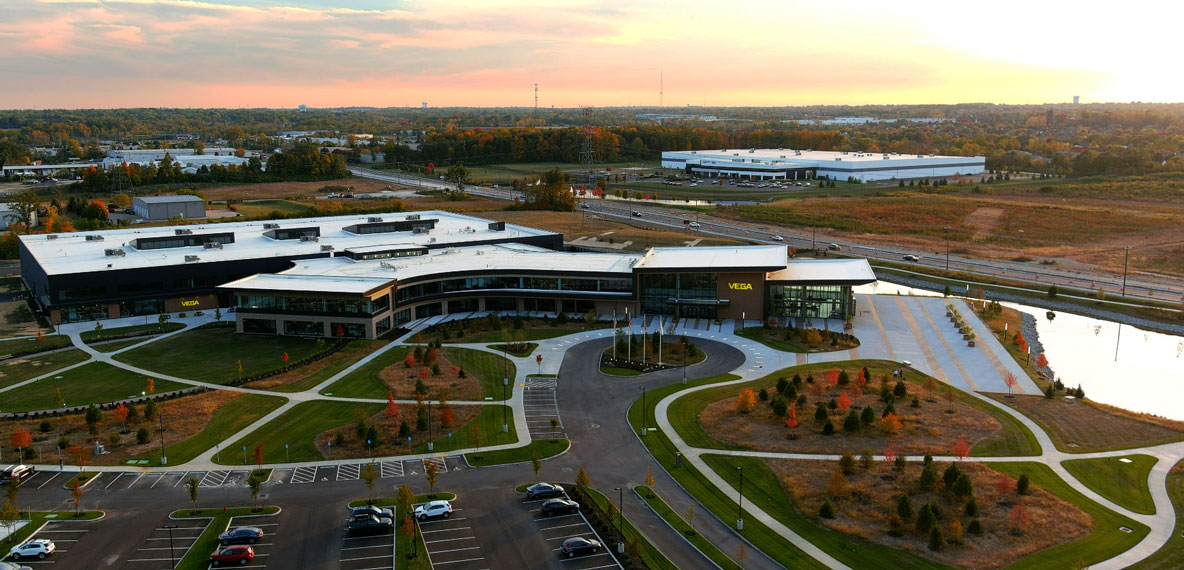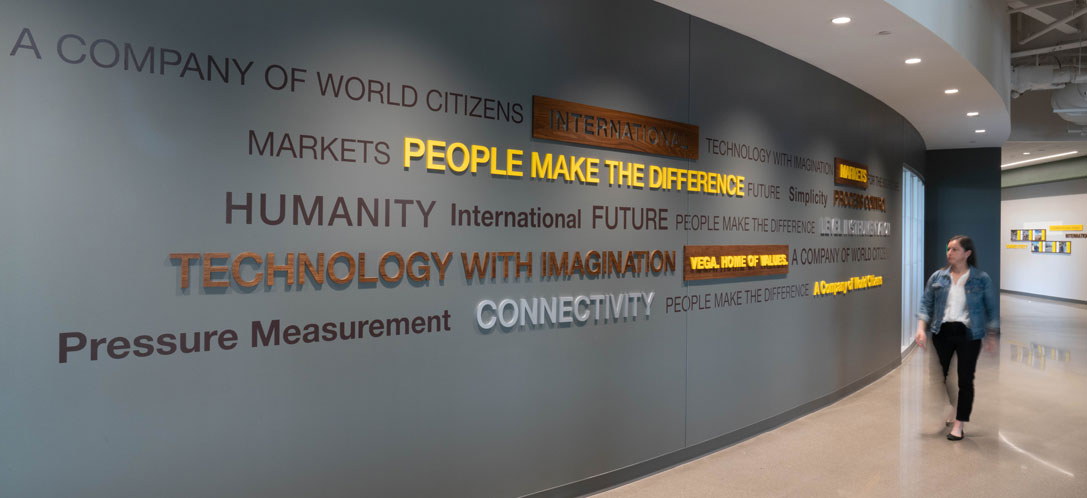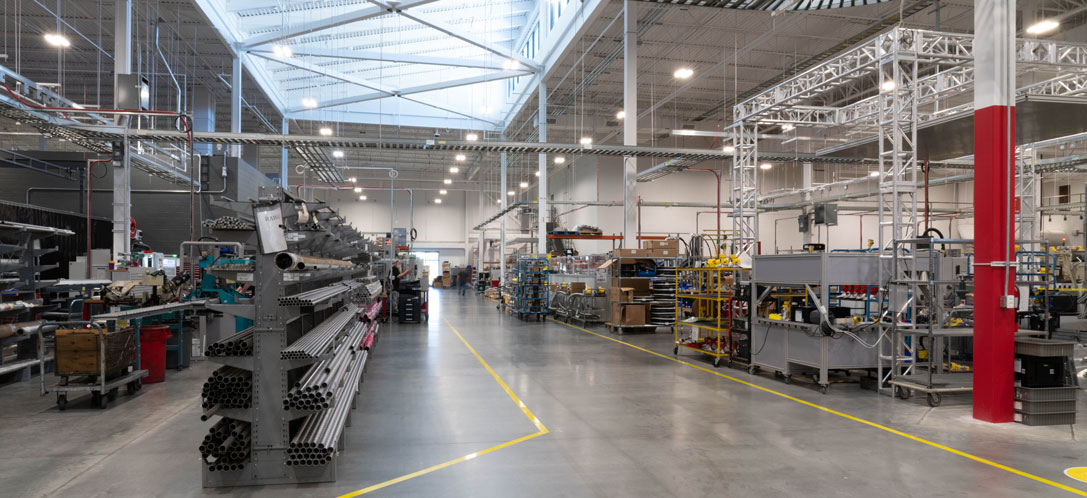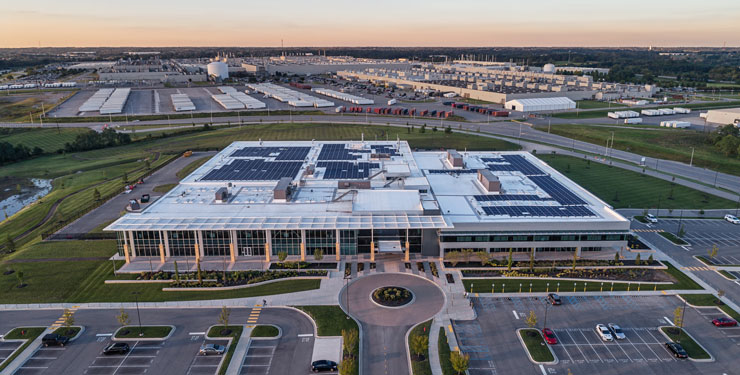
Designing Industrial Sites To Be More Socially And Environmentally Responsible

The United Nations first addressed environmental, social, and governance (ESG) reporting in 2006 in its Principles for Responsible Investment (PRI) report. Today, ESG reporting is gaining traction as a mainstream business best practice with good reason. Companies that develop ESG reports and execute those goals experience financial benefits and recognized positive environmental and social improvements.
Why ESG Reports Matter
The ESG report details an organization’s environmental and social goals and the governance mechanisms to keep it on track to meet the outlined commitments. VEGA Americas, a global sensor and measuring instrument manufacturer, relied heavily on its ESG report in the greenfield construction of its new North American headquarters and advanced manufacturing facility in Mason, Ohio. According to John Groom, VEGA Americas president, “Our ESG report centers on three principles – people, planet, and prosperity. With defined ESG goals under each principal, we aspired for our new site to be designed and built in accordance with those goals.”
Today, 92 percent of the companies on the S&P 500 produce ESG reports. Not surprisingly, the SEC is proposing rules to enhance and standardize ESG reporting. Yet, ESG reports aren’t solely the province of large, public companies. There’s a trickle-down effect on all companies as potential investors, partners, and customers consider a company’s ESG performance when deciding whether to enter into a relationship. While an ESG report doesn’t guarantee performance, it’s difficult to document performance and show commitment to environmental and social goals without it. An ESG report is also essential to recruiting and keeping talented employees seeking socially responsible employers.
There’s also growing evidence that ESG reporting correlates with improved financial performance. A meta-analysis of ESG and financial performance found that companies that care about the environment, social issues, and how they govern themselves show resilience during lean times and invigorate their financial performance through “mediating factors such as risk management and more innovation.”

Experiential graphics of company values at VEGA Americas.
Address ESG at the Start of the Design of Industrial Facilities
The ESG report is not a dusty report on a shelf. It’s an action-oriented document filled with specific environmental and social requirements the company sets for itself. It needs to be the focus of a pre-design discussion exploring how the ESG goals inform the new project. Industrial facilities present more environmental and social challenges than other commercial spaces. They emit more air and noise pollution; they’re primarily staffed with blue-collar workers and historically located in lower-income areas. All these conditions raise ESG issues not faced by other types of facilities.
Environmental Considerations
Building a two million-square-foot manufacturing facility has the potential to emit a lot of carbon into the atmosphere. Early ESG discussions should address minimizing its environmental impact and how the company plans to address this impact to stay on course to reach its environmental goals stated in its ESG report.
Common environmental goals include achieving carbon neutrality by a certain year or reducing their overall carbon emissions by a certain percentage. Therefore, the ESG discussion for the project must also include a discussion about how the company will offset the new facility’s impact on reaching those company goals. A starting point is to plan a design that exceeds the energy code requirements for the building’s envelope. Suppose the cost to build a more efficient envelope is five percent higher than the cost to meet the code. In that case, that extra cost will pay for itself a hundred times over in extra efficiency and staying aligned with the company’s stated environmental goals. Envelope efficiency was one strategy VEGA Americas used in designing its facility to meet its ESG goal to reduce its carbon footprint by 30 percent from a 2010 baseline.
The ESG review should also address the design of hyper-efficient systems within the facility, including:
- Site orientation
- Envelope design
- Energy reduction within operations
- Highly efficient mechanical systems
- Water heating and cooling
- HVAC
- Water reduction
- Carbon neutrality
- Recycling programs
- Low embodied carbon construction materials
One of the last ESG conversations is about renewable energy. Installation of renewable energy systems has a longer investment horizon before the company sees any financial return. The current budget will have a more immediate economic and environmental impact by improving the envelope efficiency or cooling and heating system.

Natural light entering into the floor space of a manufacturing building.
Design Wellness for All Employees and the Community
Industrial facilities serving employees and the local community attract office and manufacturing hires. Unfortunately, the quality of the aesthetic and atmosphere of the typical industrial facility doesn’t get the same attention as compared to designing workspace for managerial and white-collar workers. Still, the design impact on industrial workers’ health and work environment demands greater attention. Promoting the health and wellness of employees is a large part of the social goals companies set for themselves. This means the ESG discussion needs to address the following concerns when designing industrial space:
- The right to light: Instead of the dark space with only twitching fluorescent lights, blue-collar workers should also work in a space with natural light where they can tell whether it’s day or night. The design of VEGA Americas’ Ohio facility incorporated high ceilings with natural light for a bright, airy work environment.
- Internal air quality: The ventilation systems should provide clean air to breathe, so assessing proper oxygen levels in the air and the scope of air filtration is essential.
- Providing proper amenities: Design inviting and well-located breakrooms, cafeterias, and bathrooms.
- Outdoor space: Create an area that draws workers out of the internal, industrial environment to reconnect with nature. VEGA Americas selected the Ohio site specifically because it was a wooded area where they could build small parks and trails and easily plant more trees.
These issues deliver on the social goal of improving equity by giving industrial workers and spaces the same consideration regularly given to white-collar workspaces. A company’s social goals also dictate its involvement with the community living around the facility. With industrial facilities often constructed in low-income neighborhoods, the new facility design is an opportunity to add spaces that directly contribute to the local quality of life. It can provide areas open to the community, like a shared park and on-site facilities to partner with local schools for skilled trades instruction. It’s also an opportunity to set goals around hiring local, minority, and women-owned businesses as contractors in the facility’s construction and operations. By executing a strong internal and external social platform in the facility’s design, the company earns a local reputation as a quality employer, attracting top candidates and retaining high-performing employees. The VEGA Americas’ North American headquarters, with bright indoor and green outdoor spaces, has a 91 percent employee retention rate and a 94 percent on-time production delivery rate.
The ESG Report as a Secondary Blueprint
An effective ESG report is a valuable road map for guiding new building and renovation projects in ways that positively affect the business, the industrial site’s performance, and the people and environment around those sites. Producing the report doesn’t need to be complicated. Working with knowledgeable advisers, companies can create an ESG report focusing on the environmental and social challenges that impact industrial facilities.
This piece was originally published in Work Design Magazine.
Author
Content Type
Published Articles
Date
November 28, 2022
Market
Topic
Wellness



